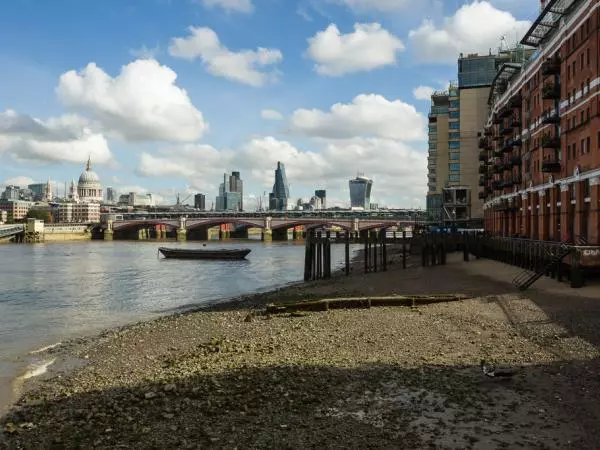
Frammenti di terra e cielo d'Occidente
Frammenti di terra e cielo
Modularità e interattività sono le parole chiave del più recente discorso artistico di Vincenza Benedetto. In questa fase s’inserisce, arricchendone la portata con nuove accezioni e interpretazioni, l’opera Frammenti di terra e cielo d’Oriente, che, come Frammenti di terra e cielo d’Occidente, suo pendant, si compone di diversi pezzi (nove) che possono vivere di vita propria, e come tali hanno avuto origine, esprimendo un’idea ben definita, precisa, individuale, ma che assumono il loro senso più profondo, vero ed efficace se accompagnati dagli altri “simili”, prodotti nelle stesse circostanze per rivelare un medesimo sentimento o punto di vista (nel solco della concezione espressionista a cui la pittrice aderisce), costruendo una frase significativa che convince proprio in quanto articolata, sintesi unitaria degli elementi che la configurano.
Se qui la libertà di disporre le tessere dipinte da parte del fruitore/utilizzatore viene meno per il fatto che esse sono state fissate dalla stessa artista su un unico supporto (una tela bianca cm 100 x 100), cristallizzando in un’immagine singola il pensiero di chi le ha via via create, non per questo svanisce la possibilità di modificare volta per volta il dato percettivo, perché il dipinto può essere letto e caricato di significati differenti a seconda del modo con cui lo si organizza visivamente, ad esempio per tre strati sovrapposti, richiamando il suo titolo e in ragione dei colori presenti e pure della corposità delle pennellate (dissolventi e ariose a salire), per non parlare del tipo di materia adottata (nel quadrante inferiore destro la sabbia è tale di nome e di fatto anziché derivare da un “color sabbia”), oppure considerandolo nel suo insieme, una sorta di caleidoscopica “finestra sul mondo”, un collage di panorami vissuti o fantasticati, o magari anche isolandone un solo membro per verificare come esso riproduca in piccolo, persino nei suoi valori cromatico-materici, lo stesso concetto o la stessa sensazione che il quadro intero intende trasmettere e suscitare in grande.
Va inoltre notato che il rimando incessante tra arte e realtà, tra materia pittorica e materia tout court, tra manufatto artistico e mondo oggettivo, che è una costante del presente stadio evolutivo dell’artista – in questo momento interprete quindi di un espressionismo che potremmo dire materico – è ben rappresentato, e risulta nel contempo accentuato, dagli spigoli al vivo dell’opera, la quale, nell’escludere l’utilizzo di una cornice, concede a chi la guarda dal fianco la visione di una parete da cui spiccano strisce di colori e di materie che evocano gli strati terrestri e atmosferici, le sedimentazioni e i mutamenti del tempo.
Dunque un’opera che, come il suo gemello Occidente (da cui si distingue per una maggiore uniformità disegnativa e coloristica tra le varie sezioni – per noi europei l’Oriente appare tutto uguale mentre il nostro mondo ci risulta una irregimentabile congerie di culture), è anche un’installazione, un quadro di quadri, un quadro/scultura, un quadro della realtà.
Earth and sky fragments from East and West
Modularity and interactivity are the key words of the most recent artistic work created by Vincenza Benedetto. In this phase we can find the work Earth and sky fragments from East, that is enriching even more its scope with new meanings and interpretations. Like his twin Earth and sky fragments from West, it consists of several pieces (nine) that can also stand alone, and indeed were created as standing alone works, expressing a well defined, precise, individual idea, but that assume their deepest, true, effective meaning, only if accompanied by their “peers”, created under the same circumstances with the aim to reveal the same feeling or point of view (in the wake of the expressionist conception whom the painter sticks to), building a significant phrase that persuades exactly because articulated, unitary synthesis of the elements that shape it.
If here there is no freedom for the public to arrange the painted pieces, because they have been fixed by the artist herself on a single support (a white canvas cm 100 x 100), crystallizing on one image the thought of who created them one after the other, there is instead the possibility to modify from time to time the perceptive data, because the painting can be read and loaded with different meanings depending on the way in which it is visually organized, for example by three layers placed ones on top of the others, referring to its title, and due to the present colours and to the paints’ thickness (fading and airy), for not to speak about the kind of used material (in the inferior right quadrant the sand is real sand, and not just a “sand colour”), or considering it wholly, a sort of kaleidoscopic window on the world, a collage of landscapes, both experienced and daydreamed of, or perhaps only isolating a single member to verify how it reproduces in miniature even in its chromatic-material values, the same concept, or the same sensation that the complete painting wants to communicate and to arouse in big.
The continuous cross-reference between art and reality, between pictorial material and proper material, between artistic work and objective world, that is always present in this evolutionary phase of the artist, is well represented, and even emphasized, by the edges of the work, which doesn’t use a frame, and then allows to whom is looking at it from one side, to see a wall in which colour stripes stand out, evoking earth and atmosphere strata, sedimentations and time changes.
Therefore a work that, like its twin “Earth and sky fragments from West” (different from “Earth and sky fragments from East” for a lower uniformity in the drawing and colours among the different sections – for us Europeans the East appears uniform while our world seems to be a mix of cultures), is also an installation, a painting of paintings, a painting/sculpture, a painting of the reality
 Share / Save
Share / Save







Commenti 0
Inserisci commento